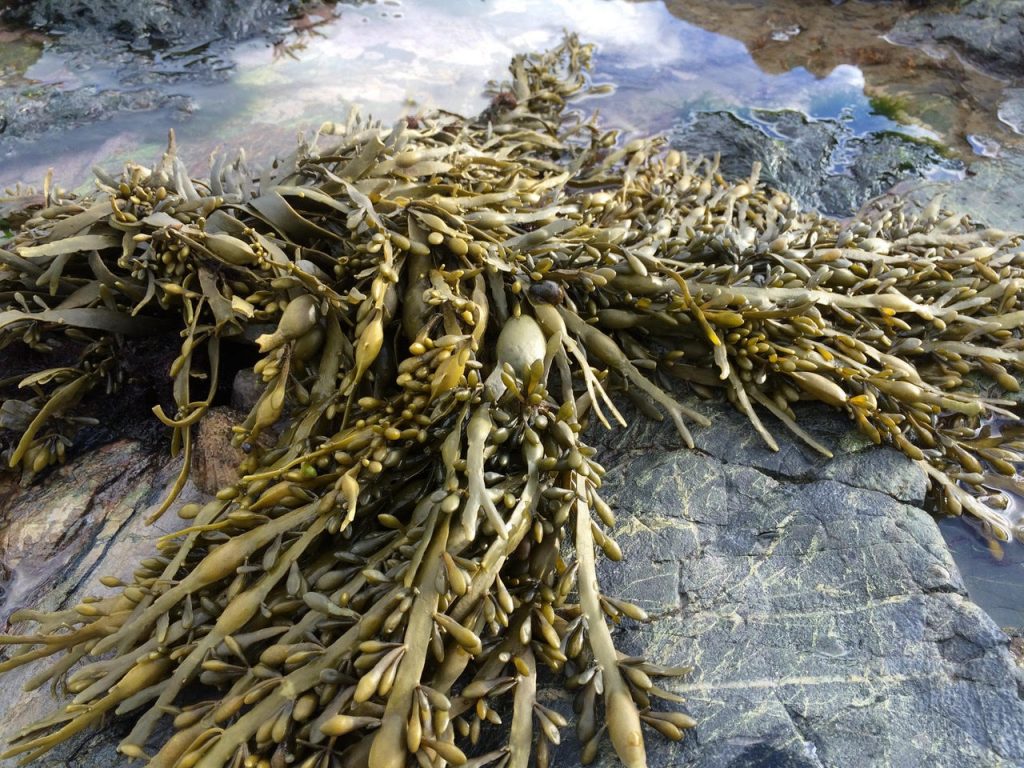Taxonomy
Kingdom: Chromista
Subkingdom: Harosa
Infra-kingdom: Heterokonta
Phylum: Ochrophyta
Subclass: Fucophycidae
Order: Fucales
Family: Fucaceae
Genus: Ascophyllum
Similar species: Fucus spp.
Previously known as: Fucus nodosus

Biological Information/Life History
| Growth Rate | >20 cm per year (Phillippi et al. 2014) |
| Size | Up to 200 cm (Maine Department of Marine Resources) |
| Life span | 50+ years (Davies et al. 2007) |
| Mating/spawning season | April-June (Sharp 1987) |
| Sessile vs non sessile | Sessile |
| Reproduction | Sexual |
| Age for reproduction | 1.5 years (Dudgeon et al. 2001) |
| Number of offspring | N/A |
| Role in food chain | Primary producer |
| Dispersal distance | > 6m (Dudgeon et al. 2001) |
Environmental Tolerances
| Temperature Range | 4-23°C (Sheader et al. 1975) |
| Salinity | N/A |
| Depth found at | Intertidal to sub-tidal zones |
Human Uses
Ascophyllum nodosum is commonly harvested off the New England coast for human use. It is often used in fertilizers and animal feed. Extracts are being experimented with in the medical industry.
Fun Fact
Extracts from Ascophyllum nodosum have anti-tumor properties.

References
Davies, A. J., Johnson, M. P., & Maggs, C. A. (2007). Limpet grazing and loss of Ascophyllum nodosum canopies on decadal time scales. Marine Ecology Progress Series, 339, 131–141. https://doi.org/10.3354/meps339131
Dudgeon, S., Kübler, J. E., Wright, W. A., Vadas, R. L., & Petraitis, P. S. (2001). Natural variability in zygote dispersal of Ascophyllum nodosum at small spatial scales. Functional Ecology, 15(5), 595–604. https://doi.org/10.1046/j.0269-8463.2001.00559.x
Fegley, J. (2001). Ecological implications of rockweed, Ascophyllum Nodosum(L.) le jolis, harvesting. The University of Maine, 214. Retrieved from http://digitalcommons.library.umaine.edu/etd/397/
Hurlbut, C. J. (1991). Larval substratum selection and postsettlement mortality as determinants of the distribution of two bryozoans. Journal of Experimental Marine Biology and Ecology, 147(1), 103–119. https://doi.org/10.1016/0022-0981(91)90040-4
In, F., & Airoldi, L. (2003). The Effects of Sedimentation on Rocky Coast Assemblages. Oceanography and Marine Biology, 41, 161–236. Retrieved from https://www.researchgate.net/publication/228458759_The_Effects_of_Sedimentation_on_Rocky_Coast_Assemblages
Keser, M., Swenarton, J. T., & Foertch, J. F. (2005). Effects of thermal input and climate change on growth of Ascophyllum nodosum (Fucales, Phaeophyceae) in eastern Long Island Sound (USA). Journal of Sea Research, 54(3), 211–220. https://doi.org/10.1016/j.seares.2005.05.001
Maine Department of Marine Resources. (2014). F ISHERY M ANAGEMENT P LAN FOR R OCKWEED ( Ascophyllum nodosum ). (January). Retrieved from https://www.maine.gov/dmr/science-research/species/rockweed/documents/DMRRockweedFMPJan2014.pdf
Petraitis, P. S., & Dudgeon, S. R. (2005). First year demography of the foundation species, Ascophyllum nodosum, and its community implications. Oikos, 109(November 2004), 405–415. Retrieved from https://onlinelibrary.wiley.com/doi/abs/10.1111/j.0030-1299.2005.13782.x
Phillippi, A., Tran, K., & Perna, A. (2014). Does intertidal canopy removal of Ascophyllum nodosum alter the community structure beneath? Journal of Experimental Marine Biology and Ecology, 461, 53–60. https://doi.org/10.1016/j.jembe.2014.07.018
Riou, D., Colliec-Jouault, S., du Sel, D., Bosch, S., Siavoshian, S., Le Bert, V., … Roussakis, C. (1996). Antitumor and antiproliferative effects of a fucan extracted from ascophyllum nodosum against a non-small-cell bronchopulmonary carcinoma line. Anticancer Research, 16(3A), 1213—1218. Retrieved from http://europepmc.org/abstract/MED/8702239
Schmidt, A. L., Coll, M., Romanuk, T. N., & Lotze, H. K. (2011). Ecosystem structure and services in eelgrass Zostera marina and rockweed Ascophyllum nodosum habitats. Marine Ecology Progress Series, 437, 51–68. https://doi.org/10.3354/meps09276
Sheader, A., & Moss, B. (1975). Effects of light and temperature on germination and growth of Ascophyllum nodosum (L.) Le Jol. Estuarine and Coastal Marine Science, 3(2), 125–132. https://doi.org/10.1016/0302-3524(75)90015-8
Ugarte, R. A., Critchley, A., Serdynska, A. R., & Deveau, J. P. (2009). Changes in composition of rockweed (ascophyllum nodosum) beds due to possible recent increase in sea temperature in eastern Canada. Journal of Applied Phycology, 21(5), 591–598. https://doi.org/10.1007/s10811-008-9397-2
UMaine. (n.d.). Indicator Species Fact Sheet Rockweed,. Retrieved from https://extension.umaine.edu/signs-of-the-seasons/wp-content/uploads/sites/6/2014/08/Rockweed_Fact-Sheet.pdf
Vadas, R., Wright, W., & Miller, S. (2007). Recruitment of Ascophyllum nodosum: wave action as a source of mortality. Marine Ecology Progress Series, 61(c), 263–272. https://doi.org/10.3354/meps061263
